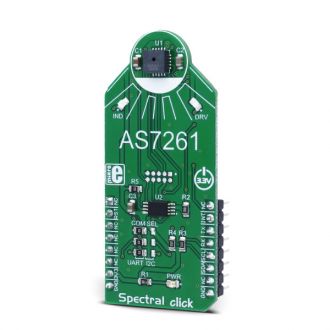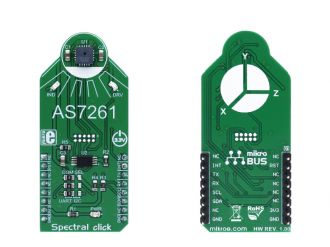
We strongly encourage users to use Package manager for sharing their code on Libstock website, because it boosts your efficiency and leaves the end user with no room for error. [more info]

Rating:
Author: MIKROE
Last Updated: 2018-03-26
Package Version: 1.0.0.0
mikroSDK Library: 1.0.0.0
Category: Optical
Downloaded: 4141 times
Not followed.
License: MIT license
Spectral click is a light multispectral sensing device, which uses the state-of-the-art sensor IC for a very accurate true-color sensing. Spectral click provides a direct reading of the XYZ color coordinates, consistent with the CIE 1931 2. standard color space.
Do you want to subscribe in order to receive notifications regarding "Spectral click" changes.
Do you want to unsubscribe in order to stop receiving notifications regarding "Spectral click" changes.
Do you want to report abuse regarding "Spectral click".


Library Description
Library initializes and defines UART driver and functions witch offer a choice to providing direct XYZ color coordinates consistent with the CIE 1931.
Key functions:
Examples Description
The demo application is composed of three sections:
void applicationTask()
{
spectral_process();
spectral_cmdSingle(&cmdData[0]);
spectral_getData(&dataBuffer[0],&readData[0]);
IntToStr(readData[0],text);
mikrobus_logWrite( "-- X value:", _LOG_TEXT );
mikrobus_logWrite( text, _LOG_LINE );
IntToStr(readData[1],text);
mikrobus_logWrite( "-- Y value:", _LOG_TEXT );
mikrobus_logWrite( text, _LOG_LINE );
IntToStr(readData[2],text);
mikrobus_logWrite( "-- Z value:", _LOG_TEXT );
mikrobus_logWrite( text, _LOG_LINE );
IntToStr(readData[3],text);
mikrobus_logWrite( "-- NIR value:", _LOG_TEXT );
mikrobus_logWrite( text, _LOG_LINE );
IntToStr(readData[4],text);
mikrobus_logWrite( "-- D value:", _LOG_TEXT );
mikrobus_logWrite( text, _LOG_LINE );
IntToStr(readData[5],text);
mikrobus_logWrite( "-- C value:", _LOG_TEXT );
mikrobus_logWrite( text, _LOG_LINE );
mikrobus_logWrite( "---------------------", _LOG_LINE );
Delay_1sec();
}
Along with the demo application timer initialization functions are provided. Note that the timer is configured acording to the default develoment system and MCUs, changing the system or MCU may require an update of the timer init and timer ISR functions.
mikroE Libraries used in the example:
Additional notes and information
Depending on the development board you are using, you may need USB UART click, USB UART 2 click or RS232 click to connect to your PC, for development systems with no UART to USB interface available on the board. The terminal available in all MikroElektronika compilers, or any other terminal application of your choice, can be used to read the message.